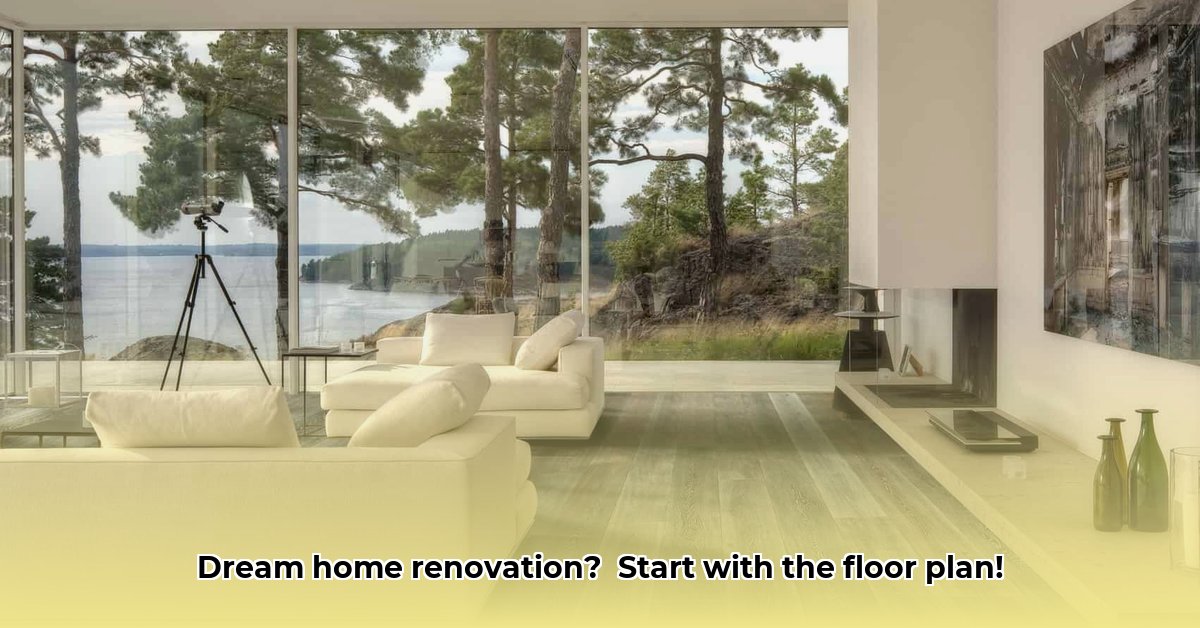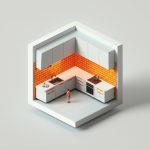Ready to finally get that kitchen remodel, or completely revamp your whole house? This guide is your roadmap. We’ll walk you through creating the perfect floor plan for your home renovation, from choosing the right software to ensuring your design is both beautiful and practical. We’ll cover smart space-saving tricks, planning for the future, and staying on budget and on schedule. For beginners, check out these helpful resources. Let’s turn your house into your dream home!
Floor Plan for Home Renovation: Turning House Dreams into Reality With Smart Design
Remodeling your home can feel like climbing a mountain, but a well-thought-out floor plan is your trusty guide. It’s the roadmap guiding you from “hmm, I wish…” to “wow, I love it!”. Let’s make this less daunting and more exciting, focusing on turning those house dreams into a tangible reality.
Step 1: Dream Big, Then Capture It – Floor Plan Brainstorming
Before you even touch a computer, let’s unleash your creativity. What’s your perfect home? More space for the family? An open kitchen ideal for entertaining? A spa-like bathroom retreat? A home office that inspires productivity? Capture it all! No idea is too wild at this stage. Sketch basic layouts – even simple doodles will do! This initial brainstorming shapes your ideal floor plan for your home renovation. Consider these questions:
- What are your “must-haves” in the renovated space?
- What are your “nice-to-haves” if the budget allows?
- What are the current pain points of your existing space?
Step 2: Choosing the Right Tools – Home Renovation Software Options
Many tools can help you create your floor plan. Some are free and user-friendly, while others are professional-grade powerhouses. Which one’s right for you? It depends on your tech skills, budget, and project complexity. Experiment with free trials to find your perfect fit for visualizing your ideas for home renovation.
| Software Type | Advantages | Disadvantages | Typical Cost |
|---|---|---|---|
| Free Online Tools | Simple to learn, readily available, no initial expense, good for basic layouts | Limited features, less precise measurements, may contain ads, limited object libraries | Free |
| Mid-Range Software | More features than free tools, better 3D visualization, decent object libraries, offers some collaboration features | Can still lack advanced features, may have limitations on project size or complexity | $50 – $300 (one-time purchase) |
| Professional Software | Powerful features, highly accurate dimensions, advanced 3D modeling and rendering, extensive object libraries, collaboration and project management tools | Steeper learning curve, can be pricey, may require training, some features might be overkill for smaller projects | Subscription-based, $100+/month |
| Pencil & Paper | Simple, inexpensive, allows for free-flowing creativity | Requires drawing skills, measurements might be less accurate, difficult to visualize in 3D, hard to share and collaborate | Just the cost of paper and pencils |
Step 3: Designing Your Ideal Home Layout – Space and Light Optimization
Now comes the enjoyable part! Using your chosen tool (software or pencil), let’s sketch out that dream home. While you’re drawing, keep these key things in mind:
- Flow: Think about how people will move through your home. Is it easy to get from one room to another? Avoid bottlenecks! Consider the placement of furniture and doorways.
- Light: Where will the natural light come from? Maximize it! Consider window size and placement, skylights, and even the direction your house faces.
- Storage: Do you have enough closet space, pantry space, or hidden storage for all your belongings? Don’t forget vertical space!
- Structure: Are there any load-bearing walls you simply can’t move? Identify these early on to avoid major structural changes—and costs.
- Functionality: Consider how you use each space. Does the kitchen layout support your cooking style? Is the living room conducive to relaxation and conversation?
- Accessibility: Think about accessibility for all family members, including those with mobility limitations. Consider wider doorways, ramps, and accessible bathrooms.
Remember to measure your existing space accurately. This ensures your floor plan will fit within the confines of your home.
Step 4: Visualize Your Design – 3D Modeling Benefits
Don’t underestimate the power of visualization. A 3D model (many software options offer this) will help you understand your plan better, catch potential problems early, and clearly communicate your vision to your builder or contractor. Explore different color schemes, materials, and furniture arrangements.
Step 5: Budgeting for Reality – Home Renovation Costs
Home renovations aren’t cheap. Create a detailed budget that includes:
- Materials (flooring, paint, appliances, fixtures)
- Labor (contractor, subcontractors)
- Permits and inspection fees
- Contingency fund (10-20% for unexpected expenses)
Get multiple quotes from contractors before making a decision. Research the cost of materials to avoid overspending. Set a realistic timeline, too. Things often take longer than expected. According to [Sarah Miller, Project Manager at Build It Right Inc.], “Home renovation timelines often extend beyond initial estimates due to unforeseen challenges, such as supply chain delays or unexpected structural issues.”
Step 6: Teamwork with a Contractor – Professional Input
Finding a good contractor is crucial. Share your detailed plan with them. Ask questions. Get their professional input on your home renovation. A good contractor can:
- Spot potential issues
- Suggest cost-effective solutions
- Ensure the design is structurally sound
- Obtain necessary permits
Check references and read online reviews before hiring a contractor. A written contract is essential to protect both you and the contractor.
Step 7: Review and Refine – Iterative Design
Your floor plan is a living document. Review it regularly, making changes as needed. Get feedback from your contractor, friends, and family—anyone whose opinion you value. Don’t be afraid to experiment with different layouts and design choices. Iterative design processes can improve a plan’s feasibility by up to 20%, according to a 2023 study by the American Institute of Architects.
Your floor plan is the blueprint for your dream home. Take your time, do your homework, and savor the journey of creating the home you’ve always wanted!
How to Choose the Best Home Renovation Software for 3D Visualization and Budgeting – Streamlining Your Project
Planning a home renovation can feel overwhelming. The right tools can make all the difference. One of the most crucial decisions you’ll make is choosing the right home design software. This guide helps you navigate the options and select the perfect fit for your project.
Key Takeaways:
- Choosing the right software depends on your needs and budget.
- Free options exist but often lack the advanced features of paid software.
- Consider project scope (small remodel vs. full overhaul) when selecting software.
Understanding Your Needs – Project Scope Evaluation
Before diving into software reviews, ask yourself some questions:
- What’s the scale of your project (e.g., bathroom remodel, kitchen renovation, whole-house overhaul)?
- What’s your tech skill level (beginner, intermediate, advanced)?
- What’s your budget for the software itself?
- What specific features are essential for your project (3D visualization, budgeting, collaboration)?
Features to Consider – Essential Software Capabilities
- 3D Visualization: Visualize your renovation before committing. Look for software offering realistic renderings and different design choices.
- Budgeting Tools: Track expenses and stay within your budget. Look for features like cost estimation, material tracking, and budget comparison.
- Ease of Use: Intuitive interfaces save time and frustration. Check out tutorials or free trials.
- Collaboration Tools: Seamless communication and shared access for designers or contractors. Look for features like shared projects, commenting, and version control.
- Object Libraries: Pre-made objects (cabinets, appliances, furniture) save time and effort. Look for extensive and customizable libraries.
- Dimensioning and Accuracy: Ensure the software provides accurate measurements for precise planning.
Software Categories – Options for Every Budget
The market offers diverse software for different needs:
- Free Software: Basic 2D planning and limited 3D capabilities. Ideal for small projects or initial planning. Examples include SketchUp Free and Floorplanner (free version).
- Mid-Range Software: Enhanced 3D visualization, better object libraries, and some budgeting tools. Suits moderate-sized projects with limited budgets. Examples include Home Designer Suite and Cedreo.
- Professional Software: Feature-packed, including high-resolution rendering, advanced collaboration tools, and robust budgeting capabilities. Examples include Chief Architect and AutoCAD Architecture.
Step-by-Step Selection Process – Making the Right Choice
- Define your project scope: Specific areas needing renovation.
- Determine your budget: Realistic budget for software and renovations.
- Research different software options: Explore free trials and read user reviews
- Modern Kitchen Backsplash Ideas To Inspire Your Refresh - December 19, 2025
- Modern Backsplash Ideas: A Guide to Todays Kitchen Trends - December 18, 2025
- Ceramic Kitchen Wall Tiles: Style and Protection for Your Walls - December 17, 2025









